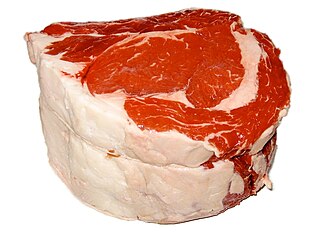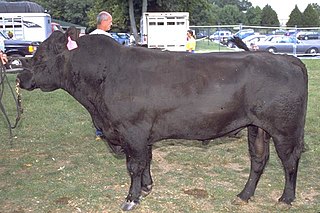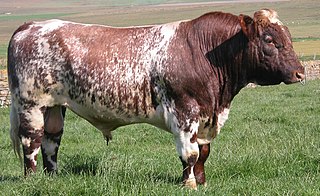Related Research Articles

Beef is the culinary name for meat from cattle, particularly skeletal muscle. Humans have been eating beef since prehistoric times. Beef is a source of high-quality protein and nutrients.

The Highland is a Scottish breed of rustic cattle. It originated in the Scottish Highlands and the Outer Hebrides islands of Scotland and has long horns and a long shaggy coat. It is a hardy breed, bred to withstand the intemperate conditions in the region. The first herd-book dates from 1885; two different types – a smaller island type, usually black, and a larger mainland type, usually dun – were registered as a single breed. It is reared primarily for beef, and has been exported to several other countries.

The Aberdeen Angus, sometimes simply Angus, is a Scottish breed of small beef cattle. It derives from cattle native to the counties of Aberdeenshire and Angus in north-eastern Scotland.

The Hereford is a British breed of beef cattle that originated in the county of Herefordshire, in the West Midlands of England. It has been exported to many countries, and there are more than five million purebred Hereford cattle in over fifty nations worldwide. The breed was first exported from the United Kingdom in 1817, initially to Kentucky, and spreading across the United States and Canada, through Mexico, to the great beef-raising countries of South America. Today, Hereford cattle dominate the world scene from Australasia to the Russian steppes. They can be found in Israel, Japan and throughout continental Europe and Scandinavia, in the temperate parts of Australia, Canada, the United States, Kazakhstan and Russia, in the centre and east of Argentina, in Uruguay, in Chile, and in New Zealand, where they make up the largest proportion of registered cattle. They are found all around Brazil and they are also found in some Southern African countries. They originally found great popularity among ranchers of the American Southwest, testament to the hardiness of the breed; while originating in cool, moist Britain, they have proven to thrive in much harsher climates on nearly every continent.

Holstein Friesians are a breed of dairy cattle originating from the Dutch provinces of North Holland and Friesland, and Schleswig-Holstein in Northern Germany. They are known as the world's highest-production dairy animals.

The Galloway is one of the world's longest established breeds of beef cattle, named after the Galloway region of Scotland, where it originated, during the 17th century.

Kobe beefpronounced [koːbe biːɸɯ] is Wagyu beef from the Tajima strain of Japanese Black cattle, raised in Japan's Hyōgo Prefecture according to rules set out by the Kobe Beef Marketing and Distribution Promotion Association. The meat is a delicacy, valued for its flavor, tenderness, and fatty, well-marbled texture. Kobe beef can be prepared as steak, sukiyaki, shabu-shabu, sashimi, and teppanyaki. Kobe beef is generally considered one of the three top brands, along with Matsusaka beef and Ōmi beef or Yonezawa beef.

Dairy cattle are cattle cows bred for the ability to produce large quantities of milk, from which dairy products are made. Dairy cows generally are of the species Bos taurus.

Wagyupronounced [ɰa'ɡʲɯː], is any of the four Japanese breeds of beef cattle.

Dexter cattle are a breed of cattle originating in Ireland. The smallest of the European cattle breeds, they are about half the size of a traditional Hereford and about one-third the size of a Holstein Friesian milking cow. A rare breed until recently, they are now considered a recovering breed by the Livestock Conservancy.

The South Devon is a British breed of beef cattle. It is the largest of the British native breeds, and is believed to have descended from the large red cattle of Normandy which were imported during the Norman invasion of England. It is a rich, medium red with copper tints, though it varies in shade and may appear slightly mottled. It is used for beef production although it has been milked in the past. A breed association, The South Devon Herd Book Society, was founded in 1891.

The Limousin, French: Limousine, is a French breed of beef cattle from the Limousin and Marche regions of France. It was formerly used mainly as a draught animal, but in modern times is reared for beef. A herd book was established in France in 1886. With the mechanisation of agriculture in the twentieth century, numbers declined. In the 1960s there were still more than 250 000 head, but the future of the breed was not clear; it was proposed that it be merged with the other blonde draught breeds of south-western France – the Blonde des Pyrénées, the Blonde de Quercy and the Garonnaise – to form the new Blonde d'Aquitaine. Instead, a breeders' association was formed; new importance was given to extensive management, to performance recording and to exports. In the twenty-first century the Limousin is the second-most numerous beef breed in France after the Charolais. It is a world breed, raised in about eighty countries round the world, many of which have breed associations.

The Beef Shorthorn breed of cattle was developed from the Shorthorn breed in England and Scotland around 1820. The Shorthorn was originally developed as a dual-purpose breed, suitable for both dairy and beef production. However, different breeders opted to concentrate on one purpose rather than the other, and in 1958, the beef breeders started their own section of the herdbook. Since then, the Beef Shorthorns have been developed as a separate breed to the Dairy Shorthorns.

Luing cattle are a beef breed developed on the island of Luing in the Inner Hebrides of Scotland by the Cadzow brothers in 1947. It was formed by first crossbreeding Beef Shorthorn with Highland cattle and then breeding the resulting progeny with Beef Shorthorns to produce an animal three quarters Beef Shorthorn, one quarter Highland. The breed of red-brown cattle are moderately sized and extremely hardy. The intent was to produce a good beef cow with the ability to raise a calf under adverse weather conditions. It was officially recognised as a breed by the British government in 1965. The breed is still farmed today, mainly in Scotland but also in other areas of the world.

Beef cattle are cattle raised for meat production. The meat of mature or almost mature cattle is mostly known as beef. In beef production there are three main stages: cow-calf operations, backgrounding, and feedlot operations. The production cycle of the animals start at cow-calf operations; this operation is designed specifically to breed cows for their offspring. From here the calves are backgrounded for a feedlot. Animals grown specifically for the feedlot are known as feeder cattle, the goal of these animals is fattening. Animals not grown for a feedlot are typically female and are commonly known as replacement heifers. While the principal use of beef cattle is meat production, other uses include leather, and beef by-products used in candy, shampoo, cosmetics, insulin and inhalers.
The Hays Converter is a breed of cattle native specifically to Alberta, Canada. Named for Harry Hays, the agriculturalist and politician who developed the breed, it was the first pure breed of cattle created in Canada. Work on breeding the Hays Converter began in 1959, and it was officially recognized by the Canadian beef industry under the Canada Livestock Pedigree Act in December 1975. Senator Hays wished to create a cattle breed that would be based solely on production, and as such would mature to market weight as fast as possible.

A steak is a meat generally sliced across the muscle fibers, potentially including a bone. It is normally grilled, though can also be pan-fried. It is often grilled in an attempt to replicate the flavor of steak cooked over the glowing coals of an open fire. Steak can also be cooked in sauce, such as in steak and kidney pie, or minced and formed into patties, such as hamburgers.
Countries regulate the marketing and sale of beef by observing criteria of cattle carcasses at the abattoir and classifying the carcasses. This classification, sometimes optional, can suggest a market demand for a particular animal's attributes and therefore the price owed to the producer.
The Canada Agricultural Products Act (CAPA) is an Act of the Parliament of Canada. It institutes the Board of Arbitration and the Review Tribunal, the decisions of which are cognizable by the Federal Court of Canada. Registered Establishments and Accredited Laboratories are under its purview, as are national Trade-Marks and Trade in agricultural products. It also enables the Inspectorate to search and to seize agricultural products.
The Canadian Beef Cattle Research, Market Development and Promotion Agency, also known as the Canadian Beef Check-Off Agency operates the Canadian Beef Cattle Check-Off (CBCC). The legal name was officially shortened to the Canadian Beef Check-Off Agency (CBCA) in February 2017.
References
- ↑ "FAQ: How do we grade Beef?". Canadian Rocky Mountain Beef. Archived from the original on 18 June 2018. Retrieved 29 June 2018.
- ↑ "Canadian Beef Grading Agency | Canadian Beef Breeds Council". Canadian Beef Breeds Council. Retrieved 29 June 2018.
| This article about a Canadian corporation or company is a stub. You can help Wikipedia by expanding it. |